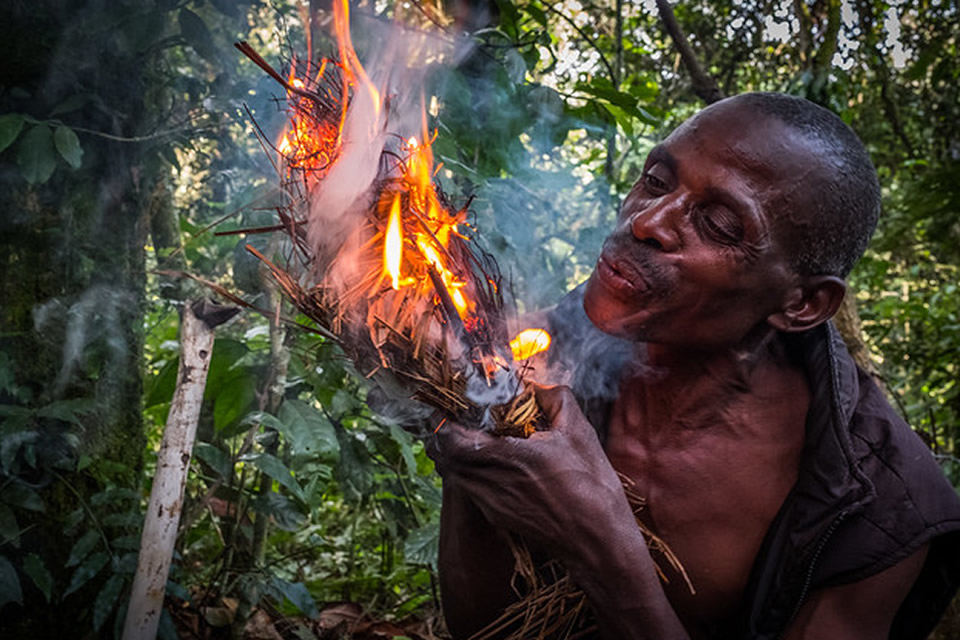The Batwa Pygmies & Their Culture
The Batwa group of people is one of the last groups of short people also known as ‘pygmy’ people. Not until Bwindi Rain forest was gazetted as a National Park they lived as hunters and gatherers of fruits in their social lifestyle in the forest. The word Pygmy is originally derived from a Greek term allegedly for the distance between the wrist and the elbow and when early Greek writers were talking about a mythical race of small people they called them Pygmies. They are now some of the poorest people in the world with a high infant mortality rate and low life expectancy.
As the original dwellers of this ancient jungle, the Batwa were known as “The Keepers of the Forest.” The history of these people is long and rich. The Batwa survived by hunting small game using arrows or nets and gathering plants and fruit in the rain forest. They lived in huts constructed by used of leaves and branches, moving frequently in search of fresh supplies of food. The Batwa lived in good terms with the forest and its creatures, including the mountain gorillas, for a number of years. The Batwa Pygmies are believed to be the original inhabitants of the equatorial forests of the Great Lakes region of Central Africa for over 60,000 years. The forest was their home. It provided them with sustenance and medicines, and contained their sacred sites. Their low-impact use of forest resources meant that their way of life was sustainable over thousands of years.
 According to a study undertaken in 1996, the Batwa reside in about 53 separate settlements falling within 41 villages. On average each settlement is composed of about 10 households. The household sizes range from single to 17 member households. Despite living in different settlements, the Batwa have strong social relations and recognize themselves as a community. They share close attachments to certain areas within social formations that appear to derive directly from the ancient past. Marriages normally take place within the clans though marriage among members of an individual settlement is rare because of the close relations amongst such persons. Batwa still practice social norms and customs normally associated with clanship similar to majority of other tribes in East and Central Africa. However, due to the resettlement programme most Batwa are never sure of their clan leader and where he lives.
According to a study undertaken in 1996, the Batwa reside in about 53 separate settlements falling within 41 villages. On average each settlement is composed of about 10 households. The household sizes range from single to 17 member households. Despite living in different settlements, the Batwa have strong social relations and recognize themselves as a community. They share close attachments to certain areas within social formations that appear to derive directly from the ancient past. Marriages normally take place within the clans though marriage among members of an individual settlement is rare because of the close relations amongst such persons. Batwa still practice social norms and customs normally associated with clanship similar to majority of other tribes in East and Central Africa. However, due to the resettlement programme most Batwa are never sure of their clan leader and where he lives.
According to the population census, the Batwa population in Uganda is about 6000, with the majority living in the Southwestern districts of Kabale, Kisoro, Kanungu, Bundibugyo and Rukungiri. The Batwa are believed to have migrated from the Ituri Forest of the DRC (Democratic Republic of Congo) in search of wild animals (game meat), hence the name Kisoro, literally meaning “the area occupied by wild animals”.
The size of the Batwa is quite different from other tribes in Uganda, men and women rise to an average of four feet or less in height, the tallest man among the Batwa would be the shortest among the neighboring community, the Bakiga. Traditionally, the Batwa lived as hunters and gatherers, residing in temporary huts and caves, deriving sustenance from forest resources like honey, wild fruits, mushrooms and vegetables. Each clan collectively owned an area of forest within which they derived food and herbal medicine for their sustenance.
